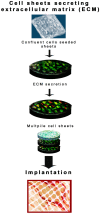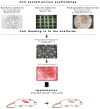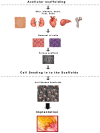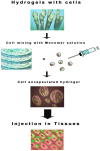Future Prospects for Scaffolding Methods and Biomaterials in Skin Tissue Engineering: A Review
- PMID: 27898014
- PMCID: PMC5187774
- DOI: 10.3390/ijms17121974
Future Prospects for Scaffolding Methods and Biomaterials in Skin Tissue Engineering: A Review
Abstract
Over centuries, the field of regenerative skin tissue engineering has had several advancements to facilitate faster wound healing and thereby restoration of skin. Skin tissue regeneration is mainly based on the use of suitable scaffold matrices. There are several scaffold types, such as porous, fibrous, microsphere, hydrogel, composite and acellular, etc., with discrete advantages and disadvantages. These scaffolds are either made up of highly biocompatible natural biomaterials, such as collagen, chitosan, etc., or synthetic materials, such as polycaprolactone (PCL), and poly-ethylene-glycol (PEG), etc. Composite scaffolds, which are a combination of natural or synthetic biomaterials, are highly biocompatible with improved tensile strength for effective skin tissue regeneration. Appropriate knowledge of the properties, advantages and disadvantages of various biomaterials and scaffolds will accelerate the production of suitable scaffolds for skin tissue regeneration applications. At the same time, emphasis on some of the leading challenges in the field of skin tissue engineering, such as cell interaction with scaffolds, faster cellular proliferation/differentiation, and vascularization of engineered tissues, is inevitable. In this review, we discuss various types of scaffolding approaches and biomaterials used in the field of skin tissue engineering and more importantly their future prospects in skin tissue regeneration efforts.
Keywords: biomaterials; natural; polymer; scaffolds; skin; synthetic; tissue engineering; wound healing.
Conflict of interest statement
The authors declare no conflict of interest.
Figures




References
-
- Alaribe F.N., Manoto S.L., Motaung S. Scaffolds from biomaterials: Advantages and limitations in boneand tissue engineering. Biol. Sect. Cell Mol. Biol. 2016;71:353–366. doi: 10.1515/biolog-2016-0056. - DOI
-
- Brahatheeswaran Dhandayuthapani Y.Y., Maekawa T., Kumar D.S. Polymeric scaffolds in tissue engineering application: A review. Int. J. Polym. Sci. 2011;2011:290602.
Publication types
MeSH terms
Substances
Grants and funding
LinkOut - more resources
Full Text Sources
Other Literature Sources

